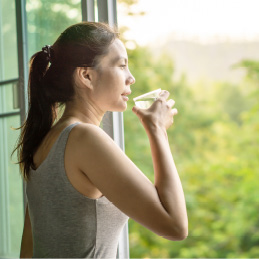6 Tips to Help You Spring Forward

It seems like just when we’re starting to feel a spring in our steps, Daylight Saving Time comes around to trip us up. Even though it doesn’t sound like much, losing that precious hour of sleep really does impact your body, and it’s enough to disrupt your sleep schedule for days. A disrupted sleep schedule is no joke since too little or poor quality sleep can weaken your immune system, making it easier to get sick.1
If you don’t have an hour to waste—let alone days—we have just the tips you need to get through the time change without feeling like you’ve lost a wink of sleep.

1. Rethink Your Drink
To no surprise, we’re really passionate about this first tip. While your usual morning mug of coffee is fine, try to limit your caffeine intake throughout the rest of the day. Your best bet for recovering from DST is to
make sure you get great sleep the night before and after the time change. Even though copious cups of coffee might keep you awake through the day, you don’t want it to keep you awake through the night too.
Instead of coffee, consider switching to low-caffeine green or white tea or caffeine-free beverages. Drinking plenty of water is always a good option, especially since even mild dehydration can sap your energy and make you feel tired.2 Alcohol can also interfere with your sleep, so don’t indulge too much late in the evening.3
 2. Enjoy the Evenings
2. Enjoy the Evenings
While we have the longer evenings before the summer hits, take advantage of them! Once the day is done, take some time to unwind before you go to sleep. Turn down the lights, turn off the screens, get cozy with a warm (caffeine-free) drink and do something relaxing like listening to a podcast, reading or meditating. Then just follow your body’s cues. Once you start feeling sleepy, it’s time to turn in and enjoy a great night’s sleep.
3. Stick to Your Schedule
Although it’s tempting to hit snooze and sleep in that extra hour, do your best to resist. Staying consistent and keeping your usual schedule is key to coping with the time change.4 Wake up and get out of bed at your usual time, even if that means pouring yourself a little extra coffee or tea just to keep from yawning.
 4. Soak Up the Sunshine
4. Soak Up the Sunshine
When you first get up, throw open the curtains and let in that springtime sunshine. The natural light will help you wake up, and in general, a touch of sunlight is helpful for chasing away fatigue and sluggishness, especially if you’ve been suffering from winter blues.5 So open your windows and let in as much light as possible, and if you can, get outside for a bit and enjoy the sun on your skin. Of course, if you do go outside, remember to apply sunscreen and take a reusable water bottle with you.
5. Get Up & Get Moving
If you find yourself nodding off at your desk in the middle of the day, it’s time to get up and get your blood pumping with some exercise. A light stretch or a short walk every couple of hours is all you need to start feeling awake and energized again. This is a good habit to get into every day, not just around Daylight Saving Time. Regular exercise can help boost your energy levels and endurance, as well as help you get better quality sleep at night.6 Just don’t do a heavy workout right before bed or you might be too revved up to fall asleep!
6. Stay Awake if You Can, Speed Nap if You Can’t
When we say stick to your schedule, we also mean avoiding the urge to take a midday nap. Powering through and staying awake all day will help you sleep well when it’s time for bed. If you absolutely can’t stay awake, though, then limit your nap to just 20 minutes. The longer your nap is, the more likely you are to feel groggy afterward, and the more likely you are to have trouble sleeping at night.4 A short, 15 to 20-minute speed nap is usually just enough time to regain some much-needed energy without disrupting the rest of your schedule. Here’s another pro napping tip: aim to nap in the early afternoon, rather than in the evenings or too close to bedtime.
Want to stay energized all season long, even after Daylight Saving Time? Then stay well-hydrated with the help of a Primo® water dispenser. Just like the flowers that are starting to spring up, you need plenty of water to bloom, so spring forward with great-tasting Primo®!
1Olsen, E. J. (2018, November 28). Can Lack of Sleep Make You Sick? Mayo Clinic. Retrieved from https://www.mayoclinic.org/diseases-conditions/insomnia/expert-answers/lack-of-sleep/faq-20057757
2Mayo Foundation for Medical Education and Research. (2020, October 14). How Much Water Do You Need to Stay Healthy? Mayo Clinic. Retrieved from https://www.mayoclinic.org/healthy-lifestyle/nutrition-and-healthy-eating/in-depth/water/art-20044256
3Mayo Foundation for Medical Education and Research. (2017, April 5). Sleep is the Foundation for Healthy Habits. Mayo Clinic Health System. Retrieved from https://www.mayoclinichealthsystem.org/hometown-health/speaking-of-health/sleep-is-the-foundation-for-healthy-habits
4Ziegler, R. (2021, March 5). How to Manage Daylight Saving Time. Mayo Clinic Health System. Retrieved from https://www.mayoclinichealthsystem.org/hometown-health/speaking-of-health/how-to-manage-daylight-saving-time
5Mayo Foundation for Medical Education and Research. (2021, December 14). Seasonal Affective Disorder (SAD). Mayo Clinic. Retrieved from https://www.mayoclinic.org/diseases-conditions/seasonal-affective-disorder/symptoms-causes/syc-20364651
6Mayo Foundation for Medical Education and Research. (2021, October 8). Exercise: 7 Benefits of Regular Physical Activity. Mayo Clinic. Retrieved from https://www.mayoclinic.org/healthy-lifestyle/fitness/in-depth/exercise/art-20048389
